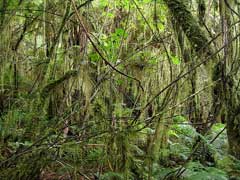 |
|
www.flickr.com/photos/mollivan_jon |
 |
|
Translate this page:
Summary
Physical Characteristics

 Ripogonum scandens is an evergreen Climber growing to 10 m (32ft 10in).
Ripogonum scandens is an evergreen Climber growing to 10 m (32ft 10in).
See above for USDA hardiness. It is hardy to UK zone 10. It is in leaf all year. The species is hermaphrodite (has both male and female organs).
Suitable for: light (sandy), medium (loamy) and heavy (clay) soils. Suitable pH: mildly acid, neutral and basic (mildly alkaline) soils. It can grow in semi-shade (light woodland). It prefers moist soil.
UK Hardiness Map
US Hardiness Map
Synonyms
Plant Habitats
Woodland Garden Sunny Edge; South Wall. By. West Wall. By.
Edible Uses
Edible Parts: Fruit Leaves Root Sap Shoots
Edible Uses:
Root - cooked. It is rich in starch[105]. The root is very fibrous and is used as a flavouring for beer[173]. Fruit - raw or cooked. Dry and uninteresting[153, 173]. The fruit is about 8mm in diameter[200]. Young shoots - cooked. They taste like fresh green beans[173]. Sap. It is obtained by blowing it out of short cut sections of the stem[173].
References More on Edible Uses
Medicinal Uses
Plants For A Future can not take any responsibility for any adverse effects from the use of plants. Always seek advice from a professional before using a plant medicinally.
Antirheumatic Skin Stomachic Vulnerary
Antirheumatic, skin, stomachic, vulnerary[61]. The burnt stems and sap are used to cauterize wounds[61].
References More on Medicinal Uses
The Bookshop: Edible Plant Books
Our Latest books on Perennial Plants For Food Forests and Permaculture Gardens in paperback or digital formats.

Edible Tropical Plants
Food Forest Plants for Hotter Conditions: 250+ Plants For Tropical Food Forests & Permaculture Gardens.
More

Edible Temperate Plants
Plants for Your Food Forest: 500 Plants for Temperate Food Forests & Permaculture Gardens.
More

More Books
PFAF have eight books available in paperback and digital formats. Browse the shop for more information.
Shop Now
Other Uses
Basketry String
The stems are used in basket making and also to make rope ladders[44, 46, 61, 128]. The stems are strong enough to be used as they are to make a rope[128].
Special Uses
References More on Other Uses
Cultivation details
We have very little information on this species and do not know if it will be hardy in Britain, though judging by its native range it is unlikely to succeed outdoors in Britain in any but the mildest areas of the country. Plants do not take kindly to cultivation, but a rich soil and shade are probably the best conditions for it[1].
References Carbon Farming Information and Carbon Sequestration Information
Temperature Converter
Type a value in the Celsius field to convert the value to Fahrenheit:
Fahrenheit:
The PFAF Bookshop
Plants For A Future have a number of books available in paperback and digital form. Book titles include Edible Plants, Edible Perennials, Edible Trees,Edible Shrubs, Woodland Gardening, and Temperate Food Forest Plants. Our new book is Food Forest Plants For Hotter Conditions (Tropical and Sub-Tropical).
Shop Now
Plant Propagation
Seed - we have no information for this species but suggest sowing the seed as soon as it is ripe in a warm greenhouse. Sow stored seed in a warm greenhouse in the spring. Prick out the seedlings into individual pots when they are large enough to handle and grow them on for at least their first winter in the greenhouse. Plant out in early summer. Division.
Other Names
If available other names are mentioned here
Native Plant Search
Search over 900 plants ideal for food forests and permaculture gardens. Filter to search native plants to your area. The plants selected are the plants in our book 'Plants For Your Food Forest: 500 Plants for Temperate Food Forests and Permaculture Gardens, as well as plants chosen for our forthcoming related books for Tropical/Hot Wet Climates and Mediterranean/Hot Dry Climates. Native Plant Search
Found In
Countries where the plant has been found are listed here if the information is available
Weed Potential
Right plant wrong place. We are currently updating this section.
Please note that a plant may be invasive in one area but may not in your area so it’s worth checking.
Conservation Status
IUCN Red List of Threatened Plants Status :

Growth: S = slow M = medium F = fast. Soil: L = light (sandy) M = medium H = heavy (clay). pH: A = acid N = neutral B = basic (alkaline). Shade: F = full shade S = semi-shade N = no shade. Moisture: D = dry M = Moist We = wet Wa = water.

Expert comment
Author
J.R.Forst.&G.Forst.
Botanical References
44200
Links / References
For a list of references used on this page please go here
Readers comment
| Add a comment |
|
If you have important information about this plant that may help other users please add a comment or link below. Only comments or links that are felt to be directly relevant to a plant will be included. If you think a comment/link or information contained on this page is inaccurate or misleading we would welcome your feedback at [email protected]. If you have questions about a plant please use the Forum on this website as we do not have the resources to answer questions ourselves.
* Please note: the comments by website users are not necessarily those held by PFAF and may give misleading or inaccurate information.
To leave a comment please Register or login here All comments need to be approved so will not appear immediately.
|
Subject : Ripogonum scandens
|
|
|
|